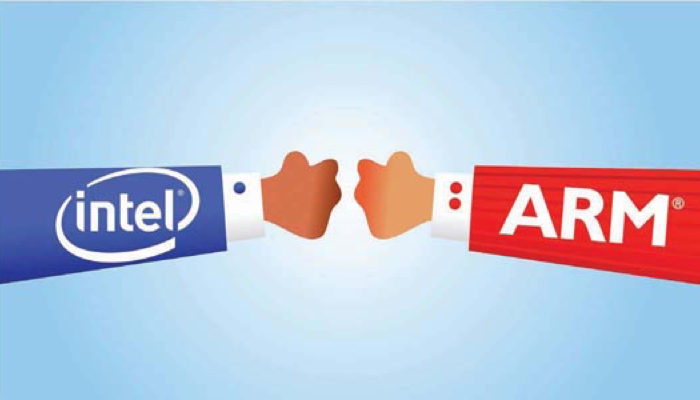Get ready for the chip wars!

Intel and their x86 computing architecture have pretty much dominated the computing industry since the late 1980s. In other words, nearly all computers that you’ve used at work or home for the past three decades have used Intel’s proprietary x86 (and later, x64) CPUs. The Intel 80-386 running DOS and Win3.1 won the PC wars by the early 1990s. Then came the Intel 80-486, Pentium, Pentium II, Pentium III, Pentium IV, Core Duos, Core i7s, as well as the AMD equivalents that ran the same x86/x64 instruction sets.
In short, if you buy a Windows PC or a Mac today, it’s got some sort of Intel or AMD CPU running the proprietary x86/x64 computing architecture that is maintained and licensed by Intel.
But that may not last much longer.
And the catalyst for this change is in your pocket: your smartphone.
When Apple released their iPhone in 2007, they changed the paradigm of “smartphone as a device” to “smartphone as a computer in your pocket” overnight. Google followed the year after with Android and the rest is history.
So how was it possible to have a phone with enough processing power to run an Internet-enabled operating system and related apps? The answer was the ARM computing architecture. ARM CPUs have existed for more than two decades before Apple released their iPhone, but their focus was not on competing for the PC market space. Instead, they were found in low-power products that required far less processing than a PC did.
But unlike Intel, the ARM computing architecture is an open architecture - this meant that vendors can easily modify ARM to suit their needs. Intel, on the other hand, is a very closed architecture, and Intel has always kept strict control over it.
This open architecture allowed ARM to evolve very quickly within the embedded device market (smartphones, GPSes, PDAs, etc.). By the mid-2000s, several manufacturers had developed very powerful ARM-based SoC (system-on-a-chip) processors that included a powerfully-evolved ARM CPU that was customized to perform tasks that would normally take a lot of different components to implement. These ARM-based SoCs are what allowed the iPhone to exist.
The smartphone market is continuing to grow at astonishing rates, and this is feeding the evolution of ARM-based SoCs. Today, a high-end smartphone contains an ARM-based SoC that has 6GB of RAM or more on the chip itself, and can perform the same tasks that you’d expect of a home PC.
Once such ARM-based SoC is the Qualcomm Snapdragon 835. This fall, Asus, HP, and Lenovo will be releasing laptop PCs running this CPU alongside Windows 10. Better yet, Microsoft is releasing an update to Windows 10 that will allow these laptops to run programs compiled for the Intel x86 platform natively on your Windows 10 ARM-based laptop!
Is Intel scared? Of course they are…just read the end of this post on their website: https://newsroom.intel.com/editorials/x86-approaching-40-still-going-strong/
Will Intel litigate? Probably. Will they win? I doubt it. Microsoft is not a company to wage war with - they rarely pick a fight they can’t win, and when it comes to patents, Microsoft has the strongest hand.
So what does this mean for technology consumers? It means that technology is about to get a lot more interesting - manufacturers are free to evolve the ARM platform to be even faster and more energy efficient. Their only limitation is how much they want to spend on research and development. And the competition between the plethora of ARM-based SoC manufacturers means that these increases in technology won’t cost a fortune.
The war is starting this year, and will rely on innovation to win. In a few years, ARM-based SoCs may dominate the laptop PC market. And if that happens, it’s likely just a matter of time before manufacturers spend the research and development money needed to evolve ARM-based SoCs in a way that they could easily take over the home and work PC markets too. We’ll just have to wait and see…regardless of what happens, the next few years will be interesting to watch!